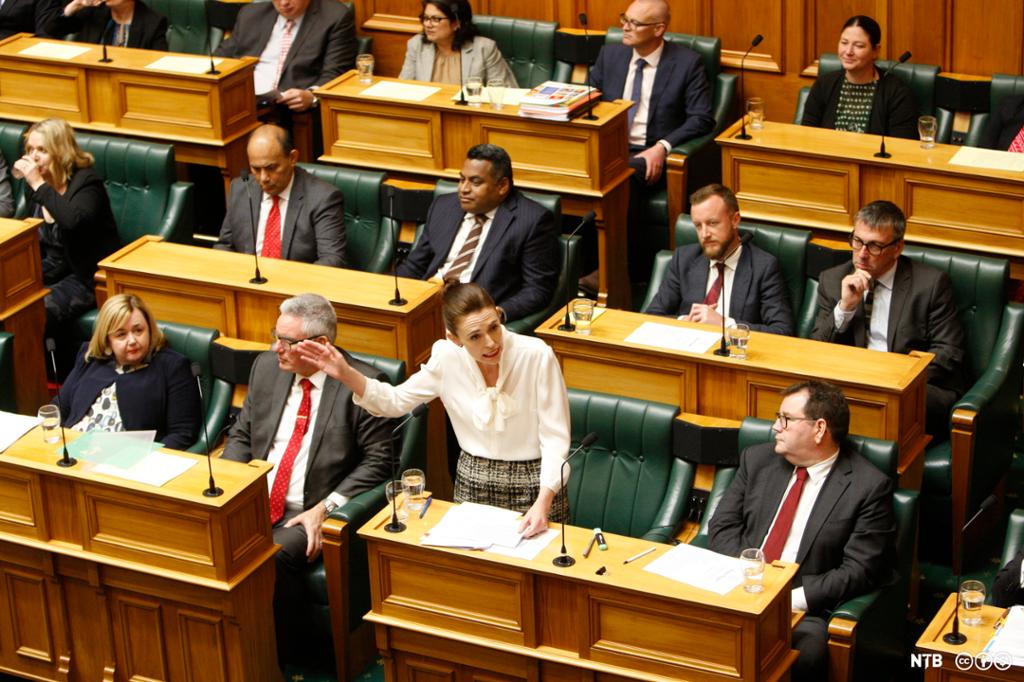Tasks: The System of Government in New Zealand
Work in groups.
How does the mixed-member proportional system (MMP) ensure that more people are represented in Parliament?
Between 1996 and 2020, New Zealand was ruled by coalition governments. Is it an advantage or disadvantage that several parties have to cooperate to decide how the country is run?
In the United States, the Supreme Court can declare laws unconstitutional. The supreme courts in Norway and New Zealand do not have this power. Do you think all supreme courts should be able to remove laws that the justices perceive to be unconstitutional?
Why do people in New Zealand have two votes in the general election?
Compare the system of government in New Zealand with the system of government in another English-speaking country. Point out similarities and difference. Present your findings to the class.
Choose one of the tasks. Present your findings in a group. End your presentation with a quiz about your topic.
Pick one political issue that is important in New Zealand today. Find out more about the issue and explain what is being done to resolve the issue.
Who is running New Zealand today? Present the government of New Zealand and explain the core ideology of the parties that are running the country.
Does the MMP system ensure fair representation of the Māori? Are Māori issues dealt with fairly in New Zealand today?
Are young people represented in New Zealand politics? What issues do young New Zealanders care about?
This is a short article about Prime Minister Jacinda Ardern. Read the article and answer the questions.
Prime Minister Jacinda Ardern

Jacinda Kate Laurell Ardern (1980–) became the 40th prime minister of New Zealand when she was elected in 2017. Ardern is the leader of the Labour Party. From 2017–2020 she led a coalition government of the Labour Party, and New Zealand First. The coalition government was supported by the Green Party. In the 2020 general election, the Labour Party won a majority in Parliament.
Ardern grew up in Morrinsville and Murupara, small towns located on New Zealand’s North Island. Ardern was interested in politics from a young age, and got involved in the student council. In 2008, she became president of the International Union of Socialist Youth, a role that allowed her to visit a number of countries around the world.
Before the election in 2017, the leader of the Labour Party, Andre Little, stepped down after an opinion poll showed record-low support for the Labour Party. Ardern took over as leader. She presented herself as a down-to-earth person who was honest, had integrity, and who believed in what Labour could accomplish in government. In just a few short weeks, Ardern was able to secure considerable support for Labour, increasing Labour’s representation in Parliament from 32 seats to 46. This was a big win for Labour, but the National Party was still the largest party in parliament. New Zealand First had to choose who they would cooperate with – did they want to maintain the status quo and cooperate with the National Party or cooperate with Labour to try a new direction for the country? After negotiations, the decision was for change. Jacinda Ardern, who on many occasions has said she did not want to become prime minister, got the important job.
Ardern received a lot of acclaim, both nationally and internationally, for the way she handled the Christchurch Mosque Shootings in 2019. Less than one month after the attack, the New Zealand Parliament passed a law that bans most semiautomatic weapons and assault rifles, parts that convert guns into semiautomatic guns, and higher capacity magazines. Ardern has also won supporters for the way she governed New Zealand during the COVID-19 pandemic, imposing strict travel restrictions and lockdown rules. Many also admire Ardern for the way she has combined the role of prime minister with being a mother to a young child; she gave birth to her first child, a daughter, in 2018.
Labour focuses on introducing important legislation to safeguard social security. One of Ardern’s stated goals has been to end child poverty. Ardern has also taken a clear stand on climate change, declaring a climate emergency in 2020 and pledging that New Zealand will become carbon neutral by 2025.
How important is it for a politician to seem honest and straight talking in today’s political world?
Do you think Jacinda Ardern is a good role model? Give reasons for your answer.
Why do you think that Ardern has become so popular internationally?
New Zealand has a general election every three years. What do you think Labour must focus on if they are to keep their majority and stay in government?
Find out more about Jacinda Ardern and the Labour party’s policies. Make a fact sheet.
Three of the people on each slide have something in common. What is it?
Discuss with a partner or in a group.
You can see their names by placing your cursor on the picture. Look them up if you don't know who they are.
There may be more than one correct answer.
Follow the link to find videos about the political system in New Zealand:
Link to Parliament New Zealand, How-to Guides
Relatert innhald
A description of the system of government in New Zealand.